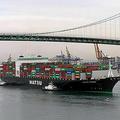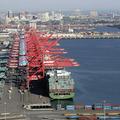 洛杉磯與長灘灣區地方官員於24日通過一項資助計畫,即對於駛近、或停靠此二灣區的船隻,進行低硫燃料油的資助。希望藉由減少運輸過程中排放的有毒廢氣,進而改善當地空氣品質。
洛杉磯與長灘灣區地方官員於24日通過一項資助計畫,即對於駛近、或停靠此二灣區的船隻,進行低硫燃料油的資助。希望藉由減少運輸過程中排放的有毒廢氣,進而改善當地空氣品質。
在威明頓(Wilmington)舉行的聯合會議上,灣區的地方官員同意此一鼓勵性質的計畫,目的在於使貨輪經營者對於聖佩德羅灣區40英哩內、與港口停泊處的船隻運輸往來,於未來一年內提高乾淨燃油使用的比率。
目前用於貨輪的燃油具有高度汙染性,為加州南方大部分氧化硫揮發的來源,同時使得遠洋船隻成為此二灣區空氣汙染的最大單一源頭。
此項計畫提出,貨輪經營者至少須在港口的20~40英哩處轉換燃油與低硫蒸餾油的使用,而港口相關單位將支付貨輪經營者關於上述兩種油品的價差支出。前述港口位於聖佩德羅灣,在洛杉磯市區南方20英哩處。
為使較乾淨的燃油與低硫燃油用於貨輪的主要推進引擎,港口相關單位將支付上百萬美元予貨輪經營者。氧化硫導致煤煙或微粒物質的形成,威脅了人體的健康;而經由此計畫的進行,氧化硫與微粒物質將分別減至11%與9%,空氣品質的提升將優於2006年「聖佩德羅港灣空氣清淨行動計畫」當中預期達到的目標。
洛杉磯灣區委員會主席費里曼(S. David Freeman)表示,「這一份共同的努力,再一次展現了洛杉磯與長灘灣區積極推動環保的領導地位。重要的是,我們持續共同為港口空氣的清淨而努力著,因此加州南方最主要的工作,就是徹底做環保。」
 長灘灣區委員會主席寇德羅(Mario Cordero)指出,「船隻名列港口的第一汙染源,我們無法再繼續等待政府的因應措施,此項計畫將大幅提升空氣品質,並且為政府於2009年起,關於低硫燃料相關規則的實施,提供一個必須的橋樑。」
長灘灣區委員會主席寇德羅(Mario Cordero)指出,「船隻名列港口的第一汙染源,我們無法再繼續等待政府的因應措施,此項計畫將大幅提升空氣品質,並且為政府於2009年起,關於低硫燃料相關規則的實施,提供一個必須的橋樑。」
此環保計畫預計將使洛杉磯灣區的年度支出增加860萬美元、長灘灣區則為990萬美元。這項為期一年的計畫,將從2008年7月1日起、2009年6月30日止,然此二灣區委員會得以決議延期。
洛杉磯灣區執行長克納茲博士(Geraldine Knatz PhD.)表示,「此計畫將對我們的客戶產生鼓勵的作用,在政府執行新規定前,即提早開始使用低硫燃油。我們港口與業界從本年度起攜手降低船隻廢氣的排放,對未來政府相關規定的適應上,是一個很好的先例。」
Los Angeles and Long Beach harbor commissioners Monday approved a plan to subsidize low-sulfur fuel to ships traveling close to the two ports or while docked. The program aims to improve air quality by reducing toxic ship emissions.
At a joint meeting in Wilmington, the harbor commissioners approved the incentive program aimed at accelerating cargo vessel operators' use of the cleaner-burning fuel for one year to ships transiting within 40 miles of San Pedro Bay and at berth in the port complex.
Cargo ships now use highly polluting bunker fuel, which generates the majority of sulfur oxide emissions in Southern California and makes ocean-going vessels the single largest source of air pollution at the two ports.
Under the incentive proposal, the ports would pay the difference between the price of bunker fuel and the more costly low-sulfur distillate fuel for vessel operators who make the fuel switch within at least 20 miles and out as far as 40 miles from the ports.
The ports are located in San Pedro Bay, 20 miles south of downtown Los Angeles.
The ports will earmark millions of dollars to pay vessel operators to use cleaner-burning, low-sulfur fuel in their main propulsion engines. Sulfur oxides, which contribute to the formation of health-threatening soot or particulate matter, will be cut by as much as 11 percent and particulate matter by nine percent, accelerating air quality improvements ahead of the schedule set by the San Pedro Bay Ports Clean Air Action Plan in November 2006.
"This joint effort demonstrates once again that these two ports are world leaders in aggressively and dramatically advancing environmental protection," said Los Angeles Harbor Commission President S. David Freeman. "It's important that we continue to work together to clean the ports' air so that one of Southern California's biggest job generators is also known as its greenest."
"Ships are the No. 1 pollution source here at the ports and we don't want to keep waiting for state regulations to kick in," said Long Beach Harbor Commission President Mario Cordero. "This program will give us significant improvements in air quality and provide a much-needed bridge to the important state regulations on low-sulfur fuels that will start next year."
The incentive program is expected to cost the Port of Los Angeles as much as $8.6 million and the Port of Long Beach as much as $9.9 million annually. The one year program would begin July 1 and expire June 30, 2009, unless extended by the two commissions.
"This program will incentivize our customers to start the process of switching over to low-sulfur fuel well ahead of future state emissions rules," says Port of Los Angeles Executive Director Geraldine Knatz PhD. "It's a great example of how our ports and industry can work together cooperatively to start reducing ship emissions this year in anticipation of future regulations."
全文及圖片詳見:ENS



